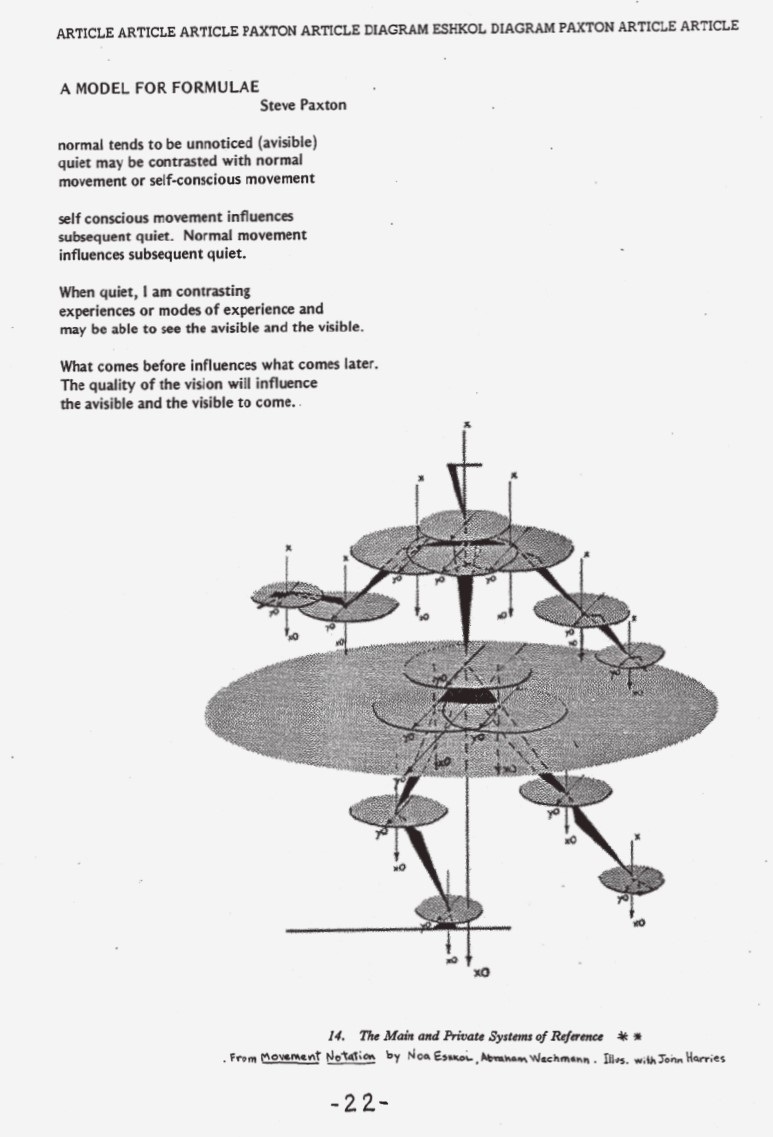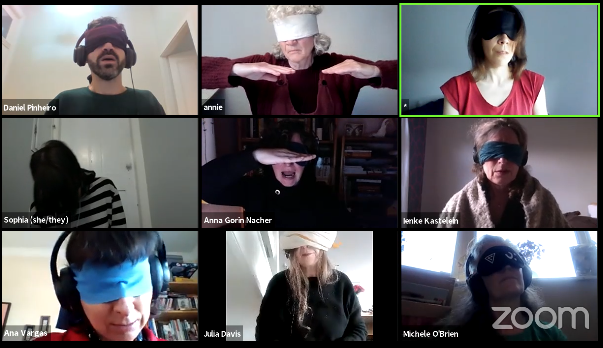we are not making music - it may be boring and that is ok - don't have ideas about what would be "good"
Audience view recommendations in zoom :
When you enter, your video and audio will be turned OFF, please leave it that way, if you click on the "up arrow" next to your camera icon ((lower left-hand toolbar) your VIDEO SETTINGS can be accessed, click the box "Hide non-video participants". Then the performers only will be visible. Select "Gallery View" in upper right corner of the ZOOM window to see the group.
Thoughts on participation
Our goal is twofold: to engage a broader audience with our exploration of “language before language,” as well as share the mechanics of our work, so as to open up the practice to more people and encourage a much needed deeper listening.
1. When you get a new module in your system (or guitar pedal in your chain), musicians talk about a period of time where you get to know the gear, and then you either "bond" with it, or you don't. It could be a top-rated piece of gear, but the interface is too complex, or it doesn't quite achieve the sounds you desire, or it doesn't work well with the rest of your system, etc. So I'm not bothered by the idea of "instrumentalizing" audience members as tools, but with some relational bonding time prior to slotting them into the system. The performance will still be improvisational, but the bonding time needs to be relational.
2. With our outgoing US orange-faced president, it has become clear that many of the rules of US democracy are contingent on all parties acting in good faith. It is not a foolproof system of laws (as our current fool of a president has foregrounded). Likewise, our performances work because of a general relational courtesy amongst us as individuals. The constraints alone are just guides. We all act in good faith. I don't relish the idea of being blindfolded for an extended period of time with a wildcard audience participant not acting in good faith running amuck in my ear space. But a workshop environment would allow us a chance to establish a culture of courtesy and good faith.

Workshop / performance: Utterings+++
04/04 2021 "Weaving Triggers"
11/04 2021 "! {Tricks & Habits}"
18/04 2021 "Patatuning"
5.00 – 6.30 pm UTC, workshop.
6.30 – 7.00 pm UTC, performance.
Duration workshop 90 min. Performance 30 min. Reflection afterwards 15 min.
Guided by a minimum of 3 Utterings members. Informal exchange. Bonding.
Max 6 participants.
INSCRIPTION on the We're All Batts website
Provisional program:
1. Presentation.
2 Technical zoom settings sound - image
3. Listening to a part of one of the Utterings recordings together.
4. Meeting Utterings. Talking about the what how who, Andanconnerdercu = Weaving a web of interrelated actions. Working with triggers for sound and movement to go beyond personal habits. Importance of Attunement.
5. Preparing for a guided Utterings experiment: Finding individual triggers. Attuning (lonely listening),
6. Guided Utterings experiment.
7. Watching and digesting first utterings experience.
8. Preparing for the final performance: Selecting an attunement piece .
Preparing individual triggers each one alone.
Performance with workshop participants.
We're All Bats Listening Arts Channel
RSVP / Booking
workshop max 6 participants
Samuel Beckett once evoked being with an image of the tympanum, a thin membrane in the ear (commonly known as the eardrum): “I’ve two surfaces and no thickness, perhaps that’s what I feel, myself vibrating … on the one hand the mind, on the other the world, I don’t belong to either.” In the moment of speaking, I hear my own voice: being is imagined as the sensation of the tympanum resonating with the voice. The membrane marks difference as well as connection between voicing and listening, and between what is felt as inside or outside the body. Being is a threshold state, where spatial distinctions collapse into each other.
“Voicing”: In encounters between people, different forms of language communication may be happening, but we cannot be certain. What we take for a voice may not in fact be a form of address at all. (“He missed the voice, or the voice missed him.” – Fernand Deligny). Or a voice may take a form that we do not recognize as a voice. To engage with different forms of language means widening our scope of attention to different registers, so that voicing includes speech sounds and sonic utterances, but also somatic registers of bodily gesture and movement, rhythms, spatial and temporal forms, imperceptible vibrations, and silences. Voicing: “calling forth” in the impulse to mobilize oneself towards another or to “me.”
Glossary: “Rub-up”: The rub-up is what is produced in encounters between people who voice themselves through different forms of language. Bewilderment, energy, friction, heat, intimacy—the rub-up arises in grappling with unfamiliar terms, in not understanding. When language reaches its limits, our relationship with it is exposed in new ways, and in this sense the rub-up is inherently reflexive. In these conditions we learn to attune to different registers of voicing around and beyond our own, broadening the scope of communication.
Losing a sense of bodily boundaries can happen when we are dancing, attuned to another person, or immersed in nature. Many people on the spectrum describe intense feelings of a “leaky sense of self”: becoming confused with other people or with one’s surroundings, losing or having no sense of being “me,” in ways that can sometimes be existentially threatening, but also exhilarating, liberating, and joyful.
Different forms of voicing call me to listen with all the senses, because when I engage with a language I do not know, I do not know what I am listening for.
Imogen Stidworthy, Detours, e-flux Journal #115 - February 2021.
https://www.e-flux.com/journal/115/374299/detours/
This is also an occasion for utterings members to experience Utterings from the outside, to simply assist and ....
How will it be when we are more than 6?
... What if art is not communicative?
Or, what if some art is communicative, and some art is not?
Ourselves animals, active, predators, we look (naturally enough) for an active, predatory, communicative art; and when we find it, we recognise it. The development of this power of recognition and the skills of appreciation is a recent and glorious achievement.
But I submit that, for all the tremendous advances made by therolinguistics during the last decades, we are only at the beginning of our age of discovery. We must not become slaves to our own axioms. We have not yet lifted our eyes to the vaster horizons before us. We have not faced the almost terrifying challenge of the Plant...
...The art he sought, if it exists, is a non-communicative art: and probably a non-kinetic one. It is possible that Time, the essential element, matrix, and measure of all known animal art, does not enter into vegetable art at all. The plants may use the meter of eternity. We do not know.
We do not know. All we can guess is that the putative Art of the Plant is entirely different from the Art of the Animal. What it is, we cannot say; we have not yet discovered it. Yet I predict with some certainty that it exists, and that when it is found it will prove to be, not an action, but a reaction: not a communication, but a reception. It will be exactly the opposite of the art we know and recognise. It will be the first passive art known to us.
from The Acacia Seeds and Other Extracts from the Journal of the Association of Therolinguistics, by Ursula K. Le Guin
1. Weaving Triggers
Attunement: Heloise Tunstall-Behrens + Auclair, The Swarm
https://heloisetunstall-behrensandauclair.bandcamp.com/track/cloud-3
With Julia Davis-Nosko, Ienke Kastelein, Anna, Nacher, Michèle O'Brien, Sophie and Ana Vargas.

Tuned Circuits, the 2021 edition of Oscillation Festival, borrows its title from Daphne Oram, the early electronic composer and instrument inventor. In Oram’s work and writing we glimpse the possibility of a parallel between electronic and biological circuits, and a desire to perceive phenomena simultaneously from various sides. More broadly, the festival looks at practices and phenomena of tuning. Tuning is a fundament of music making. To think in terms of tuning is to think in terms of relations; of one thing coming into consonance or dissonance with another, of one thing colouring and affecting another. It is also to think in terms of time, since tuning requires a process of constant calibration: what is now in tune will not stay that way.
From Tuned Circuits, Oscillation Festival 23/04 - 02/05 2021
Program and live audio stream on https://oscillation-festival.be/
2. ! {Tricks & Habits}
Attunement: Nancy Holt & Richard Serra, Boomerang, https://youtu.be/8z32JTnRrHc (3 min.) Second: Hugo Ball, Gadji Beri Bimba? https://youtu.be/aiKHSeDlU1U .
With Julia Davis-Nosko, Anja Borowicz
3. Patatuning
Relevant: How does order spontaneously arise out of chaos? https://youtu.be/t-_VPRCtiUg
'Pataphysics explained in 2 minutes: https://www.youtube.com/watch?v=QQaVqo8ENT0
Attunements: Stabat Mater by 1. Arvo Pärt 2. Krzysztof Penderecki https://youtu.be/oFbnC_2OOJE &
https://www.youtube.com/watch?v=f403XsOAFXE
With Jet Black, Sophia, Anna Gorin Nacher, Bérénice Belpaire, Joel Cahen and Julia Davis-Nosko
From May 2021 All three workshops are featured in
We're All Bats LISTENING TO OURSELVES section:
"We examine different ways in which the act of listening can be guided to enhance and develop self awareness and the awareness of others, and become a thread that binds core selfhoods between individuals."
https://www.wereallbats.co.uk/utterings-ii